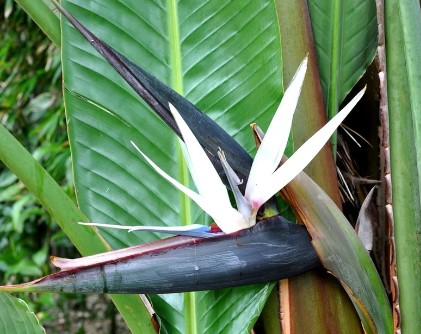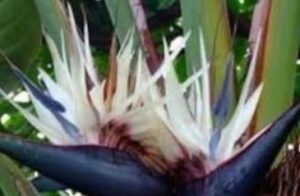The White Bird Paradise, a tropical plant also known as the crane flower, can turn any space or garden into a tropical paradise. Its striking features combined with its low-maintenance care is one of the thousands of reasons why people from different parts of the world love this plant.
If you’re one of those people who want to bring the tropics into your home or garden, you’ll be glad to know that this plant is fast-growing and is far from challenging to care for. However, like other plants, there are a few things you can do to ensure that it thrives and stays healthy all year round. These tips on White Bird of Paradise care will help you get started.

| Botanical Name | Strelitzia Nicolai |
| Common Name | White Bird of Paradise |
| Plant Type | Perennial |
| Flower Color | Bird-shaped flower with a white crown and purple-ish tongue |
| Size When Mature | 36-72 Inches |
| Bloom Time | Late Winter, Early Spring |
| Sun Requirements | Full to Partial Sun |
| USDA Hardiness Zones | 10 – 11 |
| Soil PH Range | 5.5 – 7.0 |
| Soil Type | Acidic, Neutral, and well-draining |
| Water Needs | Medium |
| Native Area | South Africa |
What You Need to Know About White Bird of Paradise
The White Bird of Paradise is a tropical plant native to South Africa. It’s a member of the Strelitziaceae family, which includes many other bird of paradise plant species. Typically, they can grow 20-30 feet tall when grown outdoors, but when grown indoors, their growth is often stunted, and they only reach a height of about 3-6 feet.
It is a large evergreen perennial with large, banana-shaped leaves. Its dark green foliage usually has white or yellow stripes running down the center.
In addition, the plant also produces flowers with a beautiful and unique shape. These flowers resemble the head of a white bird, hence the plant’s name. It has a white crown and a purple-ish tongue. Come early spring, expect these exotic-looking flowers to start blooming.
Despite its delicate and unique look, don’t underestimate the strength of this plant. It is known to be quite tough and is fairly easy to care for. Given these ideal conditions, which we’ll discuss below, this plant can thrive indoors and outdoors.
As a word of caution, take note that all parts of the plant are toxic if ingested. You may want to keep it away from curious pets and small children.
How to Care for White Bird of Paradise
Here’s everything you need to know about growing and caring for a thriving White Bird of Paradise:
Light
Despite being a tropical plant, it doesn’t tolerate direct sunlight well. It prefers bright, indirect sunlight. Some afternoon shade might be ideal if you’re situated in warmer regions where summers are long and hot.
You’ll know if your plant is getting too much sun if the leaves start to turn yellow or brown and develop scorch marks. If this happens, immediately move it to a shadier spot.
Typically, this beautiful plant won’t mind being in the shade. However, be prepared for it to grow slower and produce fewer flowers. If you can, try to give it some bright, indirect sunlight for at least a few hours every day. Some sun coming from the windowsill or a brightly lit room should do the trick.
Water and Soil Needs
This stunning tropical plant can tolerate periods of drought. However, this doesn’t mean that you should neglect it completely. Water the White Bird of Paradise 1-2 times weekly or when the soil is dry to the touch. Depending on where you live, you might need to water it more or less frequently.
The best way to water this plant is to soak it thoroughly and then allow the topsoil to dry out completely before watering it again. Similar to other indoor plants and other plants, for that matter, overwatering may lead to numerous problems such as root rot.
The White Bird of Paradise prefers well-draining soil with a pH range of 5.5-7.0. To help with drainage, make sure the pot has holes at the bottom, or a light potting mix with excellent drainage helps. Alternatively, you may also use a cactus mix, as it provides good drainage while still retaining some moisture.
If planting outdoors, ensure that the soil is loose and sandy.
Temperature Requirements
Typically found thriving and blooming profusely in USDA zones 10-11, it prefers an environment with a temperature that ranges between 55-70 degrees Fahrenheit. Considering it’s a tropical plant, its leaves will wilt and drop off once environmental, and soil temperature drops below 29 degrees Fahrenheit.
Fertilizer
The best fertilizer to use on a White Bird of Paradise is balanced fertilizer, preferably one with a 1-1-1 NPK ratio or any well-balanced liquid or granular fertilizer.
Fertilize your plant about 1-2 times a month during the spring and summer or when it’s actively growing. Once winter approaches, cut back on fertilizing to about once every 1-2 months. The plant remains dormant this season, so it doesn’t need as much fertilizer.
Common Diseases
Root rot is the most common disease affecting the White Bird of Paradise. This can occur if the plant is overwatered or if the soil does not drain well. How will you know if you’re overwatering? You can keep a popsicle stick or wooden skewer handy and insert it into the soil. If it comes out with soil sticking to it, that means the soil is still moist and doesn’t need to be watered yet. Another way to tell if overwatering is the problem is by looking at the leaves. If they’re wilting, yellowing, or browning, it’s a good indication that you might be watering your plant too much.
White Bird of Paradise Propagation
Reproducing the White Bird of Paradise is relatively easy. The most common method is cutting, which can be done during early spring. Start by taking a 6-8 inch cutting from an established plant. Carefully inspect the cutting and remove any leaves that are present near the bottom. The leaves will only get in the way, making it more difficult for the plant to grow roots. Let the cuttings dry for a few hours before planting them in moist potting mix or cactus mix.
Place the cutting in an area that receives bright, indirect sunlight and water it regularly. After that, the cutting should start to grow roots within a few weeks. Monitor the plant for any signs of stress, such as wilting leaves, and adjust the watering schedule accordingly.
Once it has established roots, you can transplant it into a larger pot or outdoors. You may also be interested in growing orange bird of paradise flowers alongside your white plant.

